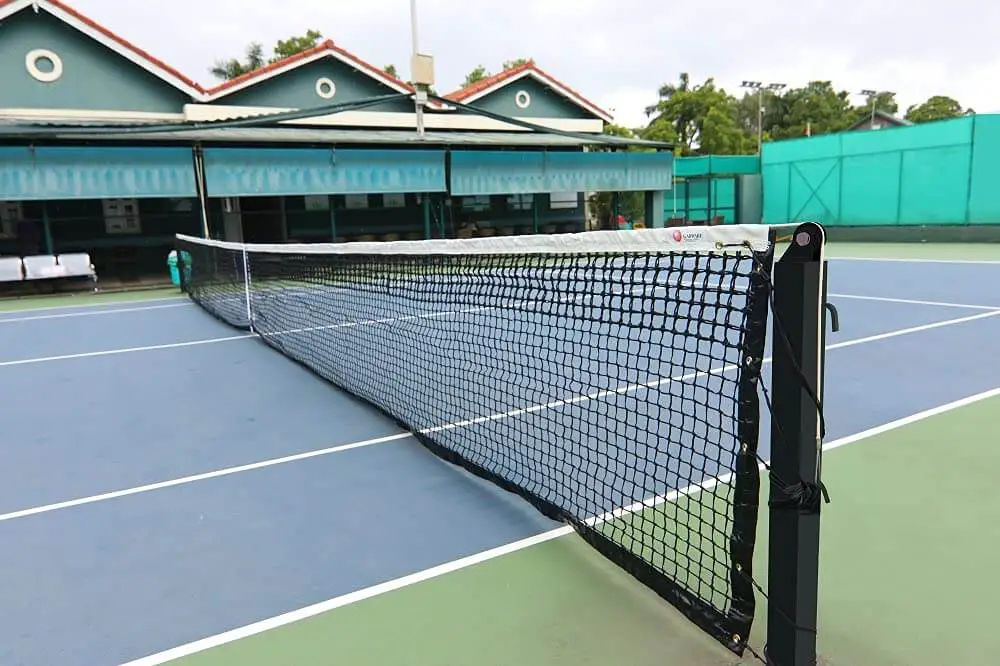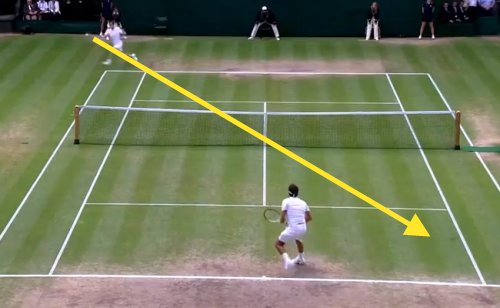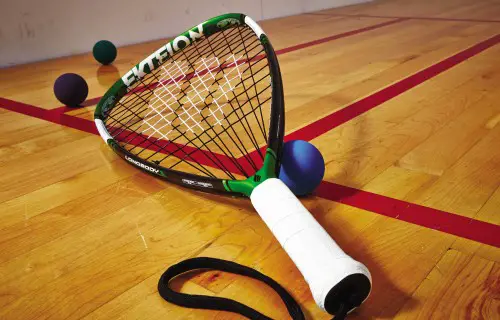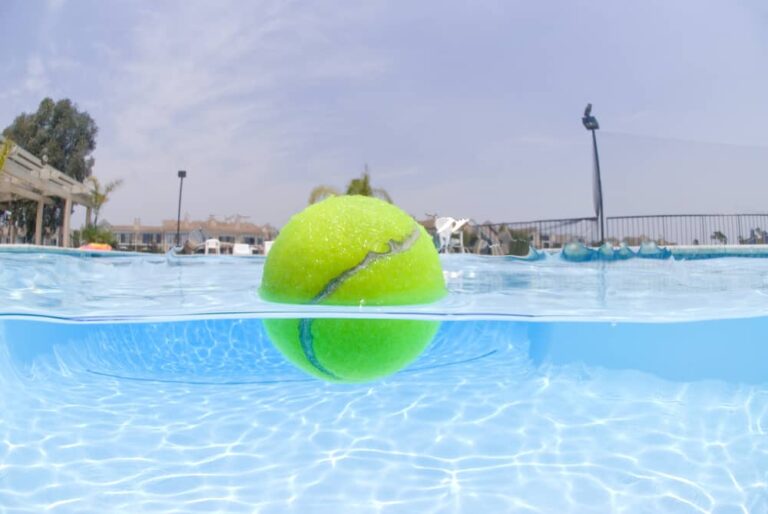Can Your Racket Cross The Net In Tennis?
Yes! If your racquet never hits the net, it can pass through. This does not imply that you may start hitting balls coming to your side across the net. Continue reading for details on the tennis rules.

Tennis is a well-liked and thrilling sport, and it is full of laws and regulations that make it a fair and challenging game. You might have questioned whether your racquet can cross the net during a match as a tennis player.
In this article, we delve into the intricacies of the over-the-net rule, the shots that can and cannot go over the net, techniques to avoid hitting the net, and the importance of hitting the ball first. So, let’s jump right in and uncover the answer to these questions.
Understanding the Tennis Net

Before we dive into further explanation, let’s familiarize ourselves with the net tennis rule, the shots that can and cannot go over the net.
The Over-the-Net Rule
The over-the-net rule is fundamental in tennis. It states that a player’s racquet cannot go over the net and into their opponent’s side of the court unless specific circumstances apply.
This rule is in place to maintain fairness and prevent interference with the opponent’s play. Here, I will leave a link from YouTube, So it’ll be easier after getting Visual Understanding.
Just like me, you might be thinking, when can your racquet go over the net? So here is the answer
Shots That Go Over the Net

There are various shots in tennis, some of which can go over the net. When executing shots such as volleys or overhead smashes, your racquet can extend over the net and make contact with the ball on your opponent’s side.
These shots often occur when positioned near the net, allowing you to take advantage of your opponent’s weak or short shots.
Shots That Cannot Go Over the Net
While certain shots allow your racquet to go over the net, some shots cannot cross the net. When hitting groundstrokes, serves, or return shots, your racquet should stay on your side of the court.
Hitting the net during these shots is considered a fault, resulting in the loss of the point or a replay of the shot, depending on the circumstances.
A massive audience on Quora discusses this query. Please take a look here at the link we’ve inserted.
Can You Jump Over The Net In Tennis?

No, you are not allowed to jump over the net in tennis. The net serves as a boundary between the two sides of the court, and players must stay on their side while the ball is in play.
Tennis players cannot jump over the net while a match is in progress since it is against the rules. Players have, however, occasionally unintentionally or accidentally crossed the net while playing. These circumstances frequently arise when a player tries to catch a ball thrown close to the net.
The Wimbledon final between John McEnroe and Jimmy Connors 1984 had a notable incident with a player crossing the net. McEnroe accidentally walked on the net while trying to make a shot during the game. He received a point penalty as a result of this.
Here’s another instance of Troicki clearing the net during a counterattack against Goffin. He leaps over the net and strikes the ball, but as the point was still active when he came down, he loses the point.
I understand that you’re curious about tennis situations where players can jump over the net. After conducting research, I found several scenarios where it is permissible for a player to cross the net. Here are some examples:
Examples of When a Tennis Player Is Allowed to Reach Over the Net

Sometimes, a tennis player may reach over the net without breaking the rules. Some instances are as follows:
Retrieving a ball
A player may reach over the net to gather a ball that has been hit close to the net while it is still in play as long as they don’t touch it or obstruct their opponent from making the shot.
Hitting a volley
Players can reach over the net to hit the ball during a volley if they don’t touch the net. A volley occurs when the ball is hit before it bounces on the ground.
Returning a lob
Players can come close to the net and reach over to hit the ball before it bounces after an opponent hits a lob, as long as they don’t touch the net.
It’s crucial to note that players should refrain from touching the net or obstructing their rival’s shot in these situations. Maintaining fair play and respecting the rules is always a good idea.
Advantages of Reaching Over the Net in Tennis

In certain tennis circumstances, reaching over the net might provide players with a few benefits. Several benefits to think about are as follows:
Retrieving difficult shots
Reaching over can help you get to balls that might otherwise be out of your reach when your opponent makes a shot close to the net. It offers you the chance to respond and continue the rally, preventing your opponent from easily winning the point.
Executing effective volleys
Reaching above the net might help you make contact with the ball in a better position during a volley, where the ball is hit before it bounces. This will let you execute volleys with more force and accuracy, making it more difficult for your opponent to return the ball successfully.
Intercepting lobs
When your opponent makes a high lob can help you catch the ball before it bounces, giving you a chance to make an aggressive overhead shot. You can pressure your opponent and win the point outright by seizing control early on.
Disrupting your opponent’s rhythm
Strategically crossing the net can throw off your opponent’s timing and rhythm. You can compel your opponent to change their shot choice or feel pressured by demonstrating your desire to be aggressive and proactive, which will increase the likelihood that they will make mistakes.
Disadvantages of Reaching Over the Net in Tennis

Tennis players should generally avoid reaching over the net since it can be dangerous and could result in rules violations. Let’s examine a few of these drawbacks:
Rule violation
Tennis players usually aren’t allowed to jump over the net, except in certain circumstances, like retrieving a ball or playing a volley. Outside of these permitted circumstances, intentionally crossing the net is a rule infraction that could result in penalties or a loss of points.
Safety hazards
Reaching across the net can be dangerous because you risk accidentally hitting the net or the other player. Both athletes could sustain injuries by tripping or losing their equilibrium, which is a possibility.
Sportsmanship concerns
Reaching over the net can be viewed as a lack of sportsmanship in tennis, a game of fair play. It may be interpreted as an attempt to obstruct or occupy the opponent, which is against the game’s rules.
Interference with an opponent
When you cross the net, you risk obstructing your opponent’s ability to execute the shot. This may cause player disputes or confrontations and obstruct the game’s progress.
Loss of focus
Reaching over the net and other such behaviors can take your focus away from the game itself. Instead of getting distracted by trying to cross the goal line, keeping your attention on your position, footwork, and successful ball hitting is essential.
Tips for Hitting An Effective Net-crossing Shot

Here are some short pointers for hitting a successful tennis net-crossing shot:
Position yourself well
Position yourself close to the goal as you anticipate your opponent’s shot. If you do this, you’ll have a better chance of getting to the ball and making a successful net-crossing shot.
Maintain a balanced stance
To respond fast and advance towards the net, keep your balance and be alert. Your ability to produce power and control in your shot will be aided by being in a stable position.
Use a compact swing
To achieve greater ball control, choose a shorter swing. Quick execution is made possible by a compact swing, lessening the likelihood of striking the net or losing control.
Aim for placement
Instead of hitting the ball with excessive power, focus on precision and placement. Try to direct the ball to a spot on the court that will give your opponent difficulty returning the shot.
Keep your eye on the ball
Maintain visual focus on the ball throughout the shot. This will help you time your shot accurately and make solid contact with the ball.
I’ll provide a link to YouTube here so you can see it visually, which will simplify things.
Do you have any more queries? Don’t worry if you’re seeking this topic; I’ve covered several similar questions.
FAQs
1. Can the ball go over the net without the racquet crossing over?
Yes, the ball can go over the net without the racquet crossing over. In tennis, the ball needs to clear the net, not the racquet.
2. What happens if a player’s racquet touches the net during a shot?
If a player’s racquet touches the net during a shot, it is considered a net violation, resulting in losing the point.
3. Can the racquet touch the net after hitting the ball?
No, the racquet should not touch the net after hitting the ball. Maintaining proper follow-through and avoiding contact with the net is essential.
4. Can a player reach over the net to hit the ball?
No, reaching over the net to hit the ball is not allowed in tennis. The ball should be hit on your side of the court without crossing the net.
5. Can the racquet go under the net during a shot?
No, the racquet should not go under the net during a shot. The shot should be executed cleanly on your side of the court without any contact with the net.
Conclusion:
To conclude, your racquet can go over the net in tennis under specific circumstances. Shots such as volleys and overhead smashes allow your racquet to extend beyond the net, but groundstrokes, serve, and return shots should stay on your side of the court.
Maintaining proper form, hitting the ball first, and implementing effective strategies are crucial for successful net play. By practicing drills, avoiding common mistakes, and understanding doubles dynamics, you can enhance your net clearance skills and overall performance on the court.






